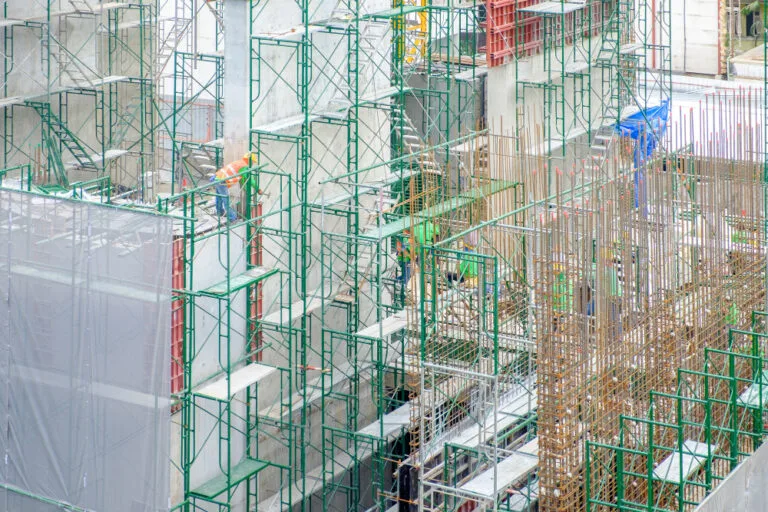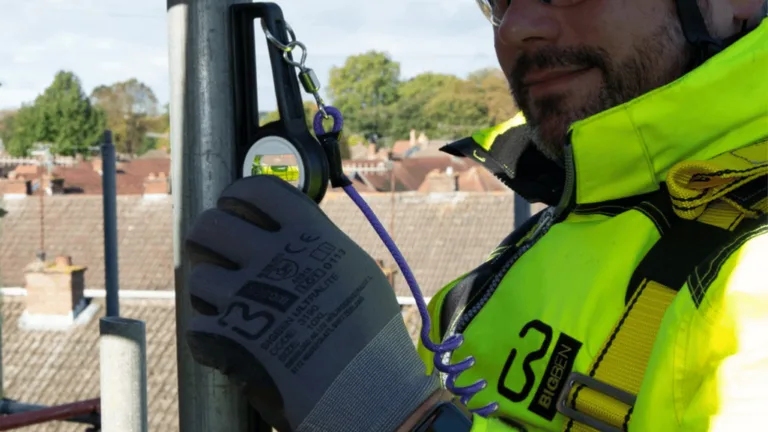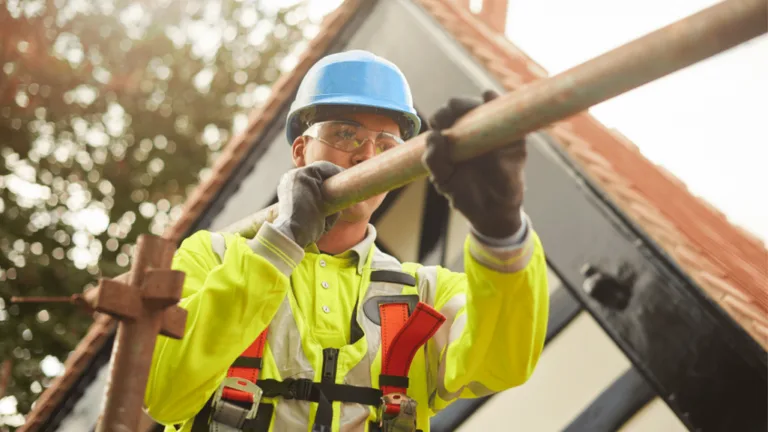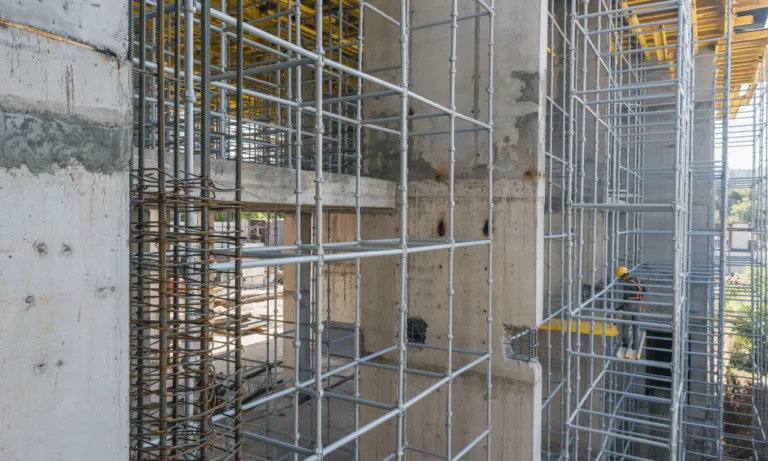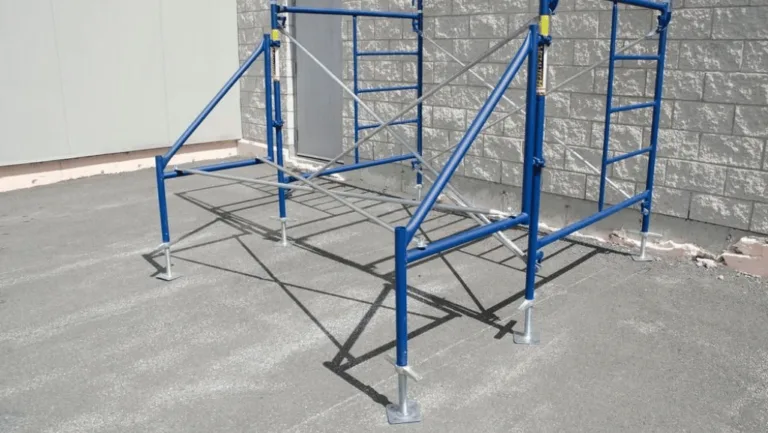Phone:
(+65)8319-0742
Scaffolding is key in the construction world. Scaffolders are vital for setting up and keeping safe, temporary structures. But, their job can be very demanding, leading to health and safety risks, like fatigue. Fatigue can make it hard for scaffolders to work safely and well, upping the chance of accidents and injuries.
To fight these risks, scaffolders need to know about fatigue and how to manage it. This guide covers basic ways to handle fatigue. It talks about safety for workers, following guidelines for scaffolding, and more.
Putting fatigue first helps scaffolders stay well and make their work safer and more efficient. Using these tips can cut down the 4,500 scaffolding injuries a year. It can also lower the costs of lost workdays, which could be up to $90 million.
Key Takeaways
- Fatigue can make it hard for scaffolders to work safely and well.
- Knowing why and how fatigue happens is key for scaffolders.
- Using strategies to fight fatigue can make work safer and better for everyone.
- Good fatigue management means following safety rules, using the right equipment, and more.
- Putting fatigue first can lessen scaffolding injuries and cut costs.
Understanding Fatigue in Scaffolding Work
Fatigue is a big worry in the scaffolding world. It can hurt worker safety, make work less productive, and affect well-being. A 2018 survey by the National Safety Council found that two-thirds of US workers feel tired at work. This means about 107 million out of 160 million workers are dealing with it.
Defining Fatigue and Its Impact on Scaffolders
Fatigue makes workers feel physically and mentally drained. It can make it hard for scaffold workers to do their job safely and well. Chronic fatigue can lead to less productivity and lower worker interest. It can also slow down reaction times, make decisions harder, and cause mistakes.
These issues can make workers more likely to get hurt on the job. This can lead to expensive workers’ comp claims and time off work.
Common Causes of Fatigue in the Scaffolding Industry
There are many reasons why workers in scaffolding get tired. Some of these include:
- Irregular work hours and long shifts, especially in busy construction times
- Not getting enough sleep because of long commutes and short breaks
- Jobs that are physically demanding, like climbing and lifting
- Working in tough conditions, like extreme weather and loud noises
- Personal habits, like smoking and poor sleep and eating habits
The table below shows how fatigue affects scaffolders:
| Fatigue Impact | Consequences |
|---|---|
| Reduced alertness and concentration | Increased risk of accidents and injuries |
| Impaired decision-making and judgment | Poor work quality and efficiency |
| Slowed reaction time | Delayed response to safety hazards |
| Physical exhaustion | Increased risk of musculoskeletal disorders |
Knowing what causes and how fatigue affects workers is key to fixing the problem. By tackling these issues, scaffolding companies can make work safer, cut down on accidents, and boost worker health and happiness.
Recognizing Signs and Symptoms of Fatigue
Fatigue management is key for scaffolders to stay safe and avoid accidents. Spotting early signs of fatigue helps workers and their bosses act fast. This can prevent health problems and accidents at work.
Physical Indicators of Fatigue
Fatigue shows in many ways, like yawning, heavy eyelids, and short naps. These signs tell scaffolders they might be getting tired. Muscle weakness and slow reflexes are also signs, making it hard to work safely and well.
Cognitive and Behavioral Changes Due to Fatigue
Scaffolders get tired, and it affects how they think and act. They might find it hard to focus, forget things, get irritable, and communicate poorly. These changes can lead to bad judgment and mistakes, upping the risk of accidents.
| Hours Awake | Equivalent Blood Alcohol Content |
|---|---|
| 17 hours | 0.05 |
| 21 hours | 0.08 |
| 24-25 hours | 0.10 |
This table shows how being awake too long affects your mind, similar to being drunk. It’s clear that fatigue can really impact your thinking.
Consequences of Ignoring Fatigue Symptoms
Not paying attention to fatigue can be dangerous for scaffolders and their team. It makes workers less alert and less able to think clearly. This can lead to more accidents and injuries, and even health problems later on.
Most workplace incidents happen late at night or early in the morning, or in the early afternoon. This shows why managing fatigue is so important during these times.
By focusing on managing fatigue early, scaffolders and their bosses can keep the workplace safe and healthy for everyone.
Importance of Sleep for Scaffolders
Sleep is key for scaffolders’ health and safety. It keeps them alert and sharp, reducing the chance of accidents. Good sleep habits are crucial for their work performance and safety.
Understanding Sleep Cycles and Circadian Rhythms
Sleep cycles and circadian rhythms help control our sleep patterns. A sleep cycle has four stages, including light and deep sleep, and REM sleep. Circadian rhythms are our body’s clock, controlling sleep and wake times. Shift workers often disrupt these rhythms, leading to fatigue and sleep issues.
Effects of Sleep Deprivation on Scaffolding Safety
Lack of sleep is a big risk for scaffolding safety. It hurts thinking skills, reaction time, and decision-making. Studies show sleep deprivation increases errors and attention lapses. The National Sleep Foundation says it raises the chance of accidents by 70%.
Scaffolders without enough sleep are more likely to have accidents and get hurt.
| Consequence of Sleep Deprivation | Effect on Scaffolding Safety |
|---|---|
| Impaired cognitive function | Difficulty concentrating and making sound decisions |
| Slowed reaction time | Inability to respond quickly to potential hazards |
| Increased risk-taking behavior | Engaging in unsafe practices on the scaffolding |
| Decreased alertness | Failure to identify and address safety concerns |
Establishing Healthy Sleep Habits for Scaffolders
To fight fatigue and perform well, scaffolders need good sleep habits. Important practices include:
- Maintaining a consistent sleep schedule, even on weekends and days off
- Creating a comfortable sleep environment that is dark, quiet, and cool
- Avoiding stimulants like caffeine and nicotine, especially before bedtime
- Engaging in relaxation techniques, such as deep breathing or meditation, to promote better sleep
- Limiting exposure to electronic devices with blue light, which can disrupt sleep patterns
Employers can help by promoting sleep hygiene and offering resources for managing fatigue. By focusing on sleep and preventing fatigue, scaffolders can stay healthy, safe, and productive at work.
Shift Work Management for Fatigue Prevention
Shift work is common in the scaffolding industry. Workers often work odd hours, night shifts, and long days. This schedule is needed to meet project goals but can lead to fatigue and health issues. Studies show that 7% to 45% of workers are fatigued, highlighting the need for good shift work management to prevent fatigue and keep workers performing well.
Challenges of Shift Work in the Scaffolding Industry
The scaffolding industry has special challenges with shift work and managing fatigue. Workers must stay alert and follow safety rules while working high up. Irregular hours and night shifts mess with their sleep, causing chronic fatigue and more accidents. Research shows that being awake for 17 hours is like having a blood alcohol level of .05, and 24 hours awake is like .10.
Scaffolding work is also physically tough, making fatigue worse. Workers may not perform as well physically and make more mistakes. Fatigue can lead to serious accidents, costing the US over $18 billion a year.
Strategies for Optimizing Shift Schedules
To fight fatigue and support workers, employers need to make shift schedules better. Important steps include:
- Limiting night shifts to help workers rest and recover
- Ensuring enough rest between shifts, at least 11 hours off
- Providing breaks during work to stop fatigue from building up
- Using shift patterns that match natural sleep cycles
- Offering flexible schedules to meet worker needs
By focusing on shift schedules, scaffolding companies can cut down on fatigue, boost worker happiness, and keep safety and productivity high.
Promoting Work-Life Balance for Scaffolders
Improving work-life balance is key to preventing fatigue and supporting workers’ health. Long hours and tight deadlines can hurt scaffolders’ personal lives, causing stress and fatigue. Employers can help by:
| Strategy | Benefits |
|---|---|
| Flexible scheduling options | Helps workers balance work and life, reducing stress and fatigue |
| Employee assistance programs | Supports workers with personal or work issues, improving mental health |
| Encouraging leisure activities | Helps workers relax and recharge, supporting a healthy balance |
| Fatigue risk management training | Teaches workers about sleep, nutrition, and stress to prevent fatigue |
By focusing on work-life balance and supporting workers, scaffolding companies can create a culture of well-being. This reduces fatigue risks and improves job performance and safety.
Nutrition and Hydration for Fatigue Management
For scaffolders, eating right and drinking enough water is key to staying energized and fighting fatigue. A diet full of complex carbs, lean proteins, and healthy fats keeps energy up all day. It helps prevent feeling tired. It’s important to plan meals and snacks to keep blood sugar stable and avoid energy dips that can affect work safety.
Drinking enough water is also vital for scaffolders. Not drinking enough water can make you feel tired, dizzy, and less sharp mentally. These effects can make it hard to work safely and well. To stay hydrated, drink water all day and avoid sugary or caffeinated drinks that can make dehydration worse.
“Water is a key factor in staying healthy, with dehydration being one of the main causes of tiredness and low energy levels. The recommended daily water intake is 1.5 litres, as around two-thirds of the body is made up of water.”
To fight fatigue, scaffolders should eat a balanced diet all day. This means:
- Eating a healthy breakfast with whole grains, proteins, fruits, and yogurt to stay alert and focused
- Choosing simple carbs in fruits, veggies, and honey for quick energy
- Adding healthy fats from olive oil, nuts, seeds, and avocados for more energy
- Staying away from processed foods, too much caffeine, and alcohol, which can make you tired
- Having smaller, more frequent meals to keep energy steady
| Nutrient | Importance for Fatigue Management |
|---|---|
| Complex Carbohydrates | Provide sustained energy release throughout the day |
| Lean Proteins | Support muscle recovery and maintain energy levels |
| Healthy Fats | Offer a concentrated energy source and support overall health |
| Vitamins and Minerals | Essential for energy production and preventing deficiencies that can lead to fatigue |
Employers in scaffolding can help workers fight fatigue by offering healthy food and water at work. By focusing on nutrition and hydration, scaffolders can stay energized, work safely, and take care of their health in this tough job.
Exercise and Physical Conditioning for Scaffolders
Regular exercise and physical conditioning are key for managing fatigue and boosting well-being in scaffolding. Adding physical activity to daily routines helps scaffolders. They gain more energy, less stress, and better sleep. These benefits help reduce fatigue and improve job performance in scaffolding work.
Benefits of Regular Exercise for Fatigue Reduction
Regular exercise helps scaffolders fight fatigue and stay healthy. Physical activity releases endorphins, which boost mood and fight tiredness. It also boosts heart health, making tasks easier and longer.
Exercise cuts down body strain and helps muscles get oxygen better. This lowers fatigue risks in scaffolding work.
Incorporating Physical Activity into Scaffolders’ Routines
Scaffolders can add exercise to their daily routines for benefits. Worksite stretching helps prevent muscle tightness and reduces injury risks. These stretches can be done before, during, and after work.
Short walks or exercises during the day help fight fatigue and keep minds sharp. Leisure activities like sports or fitness classes also improve physical conditioning and fatigue reduction.
A study in the Journal of Occupational Health shows exercise’s importance for scaffolders. It highlights the need for action to fight fatigue and boost health in this tough job.
Ergonomic Considerations for Scaffolding Work
Good ergonomic considerations are key to fighting fatigue and preventing injuries in scaffolding work. Bad posture and repetitive tasks can cause strain. Employers must provide training and gear to help scaffolders work safely.
This includes using ergonomic scaffolding, proper lifting, and regular breaks. It helps avoid stress and strain.
“Scaffolding has been referred to as a ‘young man’s game,’ with many leaving the industry prematurely due to manual handling related injuries or ill health.”
By focusing on ergonomics and injury prevention, employers can make a safer work place. This supports scaffolders’ health and cuts down on fatigue-related accidents.
| Statistic | Percentage |
|---|---|
| Construction industry professionals who think worker fatigue is a problem | 75% |
| Construction industry professionals who think worker fatigue is an overlooked hazard | 73% |
| Construction industry professionals who do not think the industry is doing enough to prevent fatigue | 65% |
The stats show the need for better fatigue management in scaffolding. By focusing on exercise, conditioning, and ergonomics, employers can make a safer, more productive work place. This benefits both workers and the industry.
Stress Management Techniques for Scaffolders
Stress is a big problem in the scaffolding industry, leading to fatigue and burnout. The work is demanding, causing high stress levels. A document from the Occupational Safety and Health Service in New Zealand says it’s key to have healthy work places and manage stress well. The Health and Safety in Employment Act of 1992 also points out the need to tackle stress and fatigue at work.
Identifying Sources of Stress in Scaffolding Work
It’s important to know what causes stress in scaffolding work. Common stressors include:
- Physical demands, like lifting heavy stuff and climbing ladders
- Long hours and tight deadlines
- Safety worries and the chance of accidents
- Not having enough food and water because of work pressure
- Workplace noise and other environmental factors
Knowing these stress sources helps scaffolders and their bosses make plans to lessen their effects on mental health and work performance.
Relaxation and Mindfulness Practices for Stress Relief
Adding relaxation and mindfulness to daily life can help scaffolders deal with stress and feel calmer. Some good ways to do this include:
- Deep breathing exercises
- Progressive muscle relaxation
- Meditation and mindfulness exercises
- Yoga and stretching
- Doing hobbies and fun activities outside of work
A study by the National Safety Council found that fatigue causes 13% of all workplace accidents. This shows how important managing stress and preventing fatigue is in scaffolding.
Employers can help by offering stress management training and resources. This could be things like yoga and stretching at work, gym memberships, and access to mental health experts. It’s also key to talk openly about stress and fatigue to create a supportive work place.
By focusing on stress management and using good coping strategies, scaffolders can get better mental health, do their jobs better, and lower the chance of accidents and injuries.
Basic Fatigue Management Scaffoler Training and Education
Training scaffolders on fatigue management is key to keeping them safe and productive. It’s important to teach them about fatigue’s causes and effects, and how to prevent and manage it. Regular training helps build a strong safety culture and prepares workers to handle fatigue well.
Importance of Fatigue Management Training for Scaffolders
Scaffolders face high risks at work, like working high up and handling heavy stuff. Fatigue can make them slower to react and less accurate, raising the chance of accidents. Training them to manage fatigue helps lower the risk of injuries and makes the workplace safer.
Elements of Effective Fatigue Management Training Programs
Good training programs mix theory with practice. They should cover:
- Understanding the causes and effects of fatigue
- Recognizing signs and symptoms of fatigue
- Strategies for preventing and managing fatigue, such as proper sleep, diet, and exercise
- Case studies and real-world examples to show how fatigue affects safety
- Role-playing and hands-on activities to teach best practices
- Advice on following laws and industry standards for managing fatigue
Ongoing Education and Refresher Courses for Scaffolders
Keeping scaffolders updated with new practices and laws is crucial. Regular training helps them remember important points, learn new ways to handle fatigue, and tackle new challenges. Employers should plan regular training to keep scaffolders sharp at managing fatigue.
| Training Type | Frequency | Key Topics |
|---|---|---|
| Initial Fatigue Management Training | Upon hiring or promotion to scaffolding role | Causes and effects of fatigue, prevention strategies, regulatory compliance |
| Annual Refresher Course | Once per year | Review of key concepts, updates on industry best practices, case studies |
| Toolbox Talks | Weekly or bi-weekly | Short, targeted discussions on specific fatigue management topics, such as sleep hygiene or stress reduction techniques |
Putting fatigue management training first helps scaffolders take steps to stay alert. It boosts a safety-first culture and meets legal standards. Training shows a company cares about its workers and aims for success.
Workplace Policies and Support for Fatigue Management
To manage fatigue in scaffolding, employers need strong workplace policies and support. These should focus on the health and safety of workers. They must tackle the unique challenges of their demanding jobs.
Developing Fatigue Risk Management Systems
Fatigue risk management systems are key for the scaffolding industry. They set rules for work hours, rest breaks, and shifts. This ensures workers get enough rest and recovery time.
Employers must also have steps to check and solve fatigue issues. This includes regular checks and ways to report incidents.
Encouraging Open Communication about Fatigue Concerns
It’s important to have a work culture that talks openly about fatigue. Workers should feel safe to report fatigue issues. Supervisors need to know how to spot and fix fatigue signs quickly.
Regular meetings and feedback help scaffolders share and solve fatigue problems together.
Providing Resources and Support for Fatigued Scaffolders
Employers should offer many resources and services for tired workers. These can include:
- Employee assistance programs for counseling and stress help
- Help with sleep habits and resources
- Changes in work for those feeling very tired
- Support from peers and mentors
- Tools and equipment that make work easier
| Support Type | Benefits |
|---|---|
| Employee Assistance Programs | Offers confidential counseling and stress help for workers |
| Sleep Hygiene Education | Teaches workers about good sleep habits to improve sleep quality and length |
| Work Accommodations | Gives temporary changes to work duties or schedules for very tired workers |
| Peer Support Networks | Creates a supportive work culture for sharing experiences and fatigue tips |
| Ergonomic Equipment | Helps reduce physical strain and fatigue with tools designed for comfort |
Strong workplace policies and support help create a place that cares about managing fatigue. This approach boosts safety and productivity. It shows a real commitment to the health of scaffolding workers.
Conclusion
Fatigue management is key for the safety, productivity, and health of scaffolders in construction. With 15 million Americans working odd hours and 25% saying work schedules don’t let them sleep well, fatigue is a big risk. By using a comprehensive approach, scaffolders and employers can make work safer and healthier.
Managing fatigue needs teamwork between employers and workers. Employers must create and use systems to manage fatigue, support tired workers, and talk openly about fatigue. Workers should sleep well, eat right, exercise, and manage stress to lessen fatigue’s effects on their work and health.
Putting fatigue management first helps the scaffolding industry be safer, cut down on accidents, and boost worker well-being. It’s important to keep improving and changing fatigue management as needed. With employers and workers working together, the scaffolding industry can foster a safe and healthy work culture. This benefits everyone and helps the industry succeed over time.





